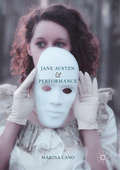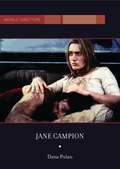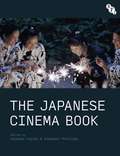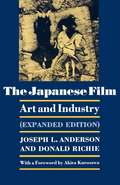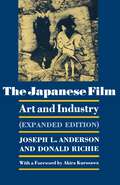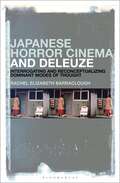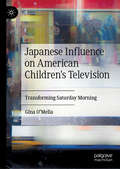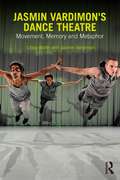- Table View
- List View
Jana Sanskriti: Forum Theatre and Democracy in India
by Sanjoy GangulyJana Sanskriti Centre for the Theatre of the Oppressed, based in West Bengal, is probably the largest and longest lasting Forum Theatre operation in the world. It was considered by Augusto Boal to be the chief exponent of his methodology outside of its native Brazil. This book is a unique first-hand account - by the group's artistic director Sanjoy Ganguly - of Jana Sanskriti's growth and development since its founding in 1985, which has resulted in a national Forum Theatre network throughout India. Ganguly describes the plays, people and places that have formed this unique operation and discusses its contribution to the wider themes espoused by Forum Theatre. Ganguly charts and reflects on the practice of theatre as politics, developing an intriguing and persuasive case for Forum Theatre and its role in provoking responsible action. His combination of anecdotal insight and lucid discussion of Boal’s practice offers a vision of far-reaching transformation in politics and civil society.
Jana Sanskriti: Forum Theatre and Democracy in India
by Sanjoy GangulyJana Sanskriti Centre for the Theatre of the Oppressed, based in West Bengal, is probably the largest and longest lasting Forum Theatre operation in the world. It was considered by Augusto Boal to be the chief exponent of his methodology outside of its native Brazil. This book is a unique first-hand account - by the group's artistic director Sanjoy Ganguly - of Jana Sanskriti's growth and development since its founding in 1985, which has resulted in a national Forum Theatre network throughout India. Ganguly describes the plays, people and places that have formed this unique operation and discusses its contribution to the wider themes espoused by Forum Theatre. Ganguly charts and reflects on the practice of theatre as politics, developing an intriguing and persuasive case for Forum Theatre and its role in provoking responsible action. His combination of anecdotal insight and lucid discussion of Boal’s practice offers a vision of far-reaching transformation in politics and civil society.
Jana Sanskriti (Routledge Performance Practitioners #24)
by Ralph YarrowRegarded by Augusto Boal as the international icon of his vision, Jana Sanskriti are the leading practitioners of Theatre of the Oppressed and Forum Theatre in India and the East. The group has worked continuously with rural communities in West Bengal since its beginnings in 1985 to reconfigure social and political relationships through theatre, achieving both a solid regional presence and an international reputation. This book combines: a biography of the group, charting their history, methodology and modes of operation an examination of Jana Sanskriti through the writings of their founder, Sanjoy Ganguly a detailed analysis of their performance events and practices, including the plays collected in Ganguly's Where We Stand (2009) practical exercises and games, taken from Jana Sanskriti's workshops and festivals. As a first step towards critical understanding, and as an initial exploration before going on to further, primary research, Routledge Performance Practitioners offer unbeatable value for today’s student.
Jana Sanskriti (Routledge Performance Practitioners #24)
by Ralph YarrowRegarded by Augusto Boal as the international icon of his vision, Jana Sanskriti are the leading practitioners of Theatre of the Oppressed and Forum Theatre in India and the East. The group has worked continuously with rural communities in West Bengal since its beginnings in 1985 to reconfigure social and political relationships through theatre, achieving both a solid regional presence and an international reputation. This book combines: a biography of the group, charting their history, methodology and modes of operation an examination of Jana Sanskriti through the writings of their founder, Sanjoy Ganguly a detailed analysis of their performance events and practices, including the plays collected in Ganguly's Where We Stand (2009) practical exercises and games, taken from Jana Sanskriti's workshops and festivals. As a first step towards critical understanding, and as an initial exploration before going on to further, primary research, Routledge Performance Practitioners offer unbeatable value for today’s student.
Jane Austen (LIVES #6)
by Carol ShieldsBestselling, award-winning novelist writing about one of the most popular and enduring English novelists of all time.'Splendid ... a gem' LITERARY REVIEW'An excellent biography' MAIL ON SUNDAY'Shields on Austen offers up a delicious prospect. And we are not disappointed' SCOTSMANJane Austen was one of the world's most remarkable writers, whose characters are as alive today as they were two hundred years ago. Despite being one of the most perceptive writers about people and relationships, she never married and always lived with her parents and sister Cassandra.Perhaps unusual for women at that time, Jane Austen was acutely aware of the larger political and social world around her, but chose to focus her novels on the family as a microcosm through which to explore human nature.The prizewinning novelist Carol Shields gives us a beautifully written, perceptive look at the life of one of the finest and most popular English novelists of all time.
Jane Austen and Performance
by Marina CanoThis is the first exploration of the performative and theatrical force of Austen’s work and its afterlife, from the nineteenth century to the present. It unearths new and little-known Austen materials: from suffragette novels and pageants to school and amateur theatricals, passing through mid-twentieth-century representations in Scotland and America. The book concludes with an examination of Austen fandom based on an online survey conducted by the author, which elicited over 300 responses from fans across the globe. Through the lens of performative theory, this volume explores how Austen, her work and its afterlives, have aided the formation of collective and personal identity; how they have helped bring people together across the generations; and how they have had key psychological, pedagogical and therapeutic functions for an ever growing audience. Ultimately, this book explains why Austen remains the most beloved author in English Literature.
Jane Austen and Performance
by Marina CanoThis is the first exploration of the performative and theatrical force of Austen’s work and its afterlife, from the nineteenth century to the present. It unearths new and little-known Austen materials: from suffragette novels and pageants to school and amateur theatricals, passing through mid-twentieth-century representations in Scotland and America. The book concludes with an examination of Austen fandom based on an online survey conducted by the author, which elicited over 300 responses from fans across the globe. Through the lens of performative theory, this volume explores how Austen, her work and its afterlives, have aided the formation of collective and personal identity; how they have helped bring people together across the generations; and how they have had key psychological, pedagogical and therapeutic functions for an ever growing audience. Ultimately, this book explains why Austen remains the most beloved author in English Literature.
Jane Campion (World Directors)
by Dana PolanWith the phenomenal success of 'The Piano' (1993), Jane Campion became revered by many as the leading female film director of the 1990s. In this book, Dana Polan examines the phenomenon of 'The Piano' and how it develops from the early shorts and first features which evoke an often surreal and critical distanced style of looking at everyday issues. Looking at all of Campion's work before and since, including 'Holy Smoke' (1999), which returned again to the battleground of gender politics, the author concludes his survey of the director's work by offering some hypotheses about the erotic thriller 'The Cut' (2001) whilst asking what variety of approaches to the study of directors might now be fruitful.
Jane Campion (World Directors)
by Dana PolanWith the phenomenal success of 'The Piano' (1993), Jane Campion became revered by many as the leading female film director of the 1990s. In this book, Dana Polan examines the phenomenon of 'The Piano' and how it develops from the early shorts and first features which evoke an often surreal and critical distanced style of looking at everyday issues. Looking at all of Campion's work before and since, including 'Holy Smoke' (1999), which returned again to the battleground of gender politics, the author concludes his survey of the director's work by offering some hypotheses about the erotic thriller 'The Cut' (2001) whilst asking what variety of approaches to the study of directors might now be fruitful.
Jane Campion and Adaptation: Angels, Demons and Unsettling Voices (The Adaptation Series)
by Estella TincknellBest known for The Piano, Jane Campion is an author/director whose films explore the relationship between literature and cinema. This book examines Campion's films as adaptations, mixing cultural and textual analysis, and exploring context, pastiche and genre. It is a must-read for anyone interested in Campion or adaptation studies.
Jane Campion and Adaptation: Angels, Demons and Unsettling Voices (The Adaptation Series)
by Estella TincknellBest known for The Piano, Jane Campion is an author/director whose films explore the relationship between literature and cinema. This book examines Campion's films as adaptations, mixing cultural and textual analysis, and exploring context, pastiche and genre. It is a must-read for anyone interested in Campion or adaptation studies.
Japanese Cinema: Texts and Contexts (Critical Concepts In Media And Cultural Studies)
by Alastair Phillips Julian StringerJapanese Cinema includes twenty-four chapters on key films of Japanese cinema, from the silent era to the present day, providing a comprehensive introduction to Japanese cinema history and Japanese culture and society. Studying a range of important films, from Late Spring, Seven Samurai and In the Realm of the Senses to Godzilla, Hana-Bi and Ring, the collection includes discussion of all the major directors of Japanese cinema including Ozu, Mizoguchi, Kurosawa, Oshima, Suzuki, Kitano and Miyazaki. Each chapter discusses the film in relation to aesthetic, industrial or critical issues and ends with a complete filmography for each director. The book also includes a full glossary of terms and a comprehensive bibliography of readings on Japanese cinema. Bringing together leading international scholars and showcasing pioneering new research, this book is essential reading for all students and general readers interested in one of the world’s most important film industries.
Japanese Cinema: Texts and Contexts
by Alastair Phillips Julian StringerJapanese Cinema includes twenty-four chapters on key films of Japanese cinema, from the silent era to the present day, providing a comprehensive introduction to Japanese cinema history and Japanese culture and society. Studying a range of important films, from Late Spring, Seven Samurai and In the Realm of the Senses to Godzilla, Hana-Bi and Ring, the collection includes discussion of all the major directors of Japanese cinema including Ozu, Mizoguchi, Kurosawa, Oshima, Suzuki, Kitano and Miyazaki. Each chapter discusses the film in relation to aesthetic, industrial or critical issues and ends with a complete filmography for each director. The book also includes a full glossary of terms and a comprehensive bibliography of readings on Japanese cinema. Bringing together leading international scholars and showcasing pioneering new research, this book is essential reading for all students and general readers interested in one of the world’s most important film industries.
Japanese Cinema Between Frames
by Laura LeeThis book explores the rich complexity of Japan’s film history by tracing how cinema has been continually reshaped through its dynamic engagement within a shifting media ecology. Focusing on techniques that draw attention to the interval between frames on the filmstrip, something that is generally obscured in narrative film, Lee uncovers a chief mechanism by which, from its earliest period, the medium has capitalized on its materiality to instantiate its contemporaneity. In doing so, cinema has bound itself tightly with adjacent visual forms such as anime and manga to redefine itself across its history of interaction with new media, including television, video, and digital formats. Japanese Cinema Between Frames is a bold examination of Japanese film aesthetics that reframes the nation’s cinema history, illuminating processes that have both contributed to the unique texture of Japanese films and yoked the nation’s cinema to the global sphere of film history.
Japanese Cinema Between Frames
by Laura LeeThis book explores the rich complexity of Japan’s film history by tracing how cinema has been continually reshaped through its dynamic engagement within a shifting media ecology. Focusing on techniques that draw attention to the interval between frames on the filmstrip, something that is generally obscured in narrative film, Lee uncovers a chief mechanism by which, from its earliest period, the medium has capitalized on its materiality to instantiate its contemporaneity. In doing so, cinema has bound itself tightly with adjacent visual forms such as anime and manga to redefine itself across its history of interaction with new media, including television, video, and digital formats. Japanese Cinema Between Frames is a bold examination of Japanese film aesthetics that reframes the nation’s cinema history, illuminating processes that have both contributed to the unique texture of Japanese films and yoked the nation’s cinema to the global sphere of film history.
The Japanese Cinema Book
by Hideaki Fujiki Alastair PhillipsThe Japanese Cinema Book provides a new and comprehensive survey of one of the world's most fascinating and widely admired filmmaking regions. In terms of its historical coverage, broad thematic approach and the significant international range of its authors, it is the largest and most wide-ranging publication of its kind to date.Ranging from renowned directors such as Akira Kurosawa to neglected popular genres such as the film musical and encompassing topics such as ecology, spectatorship, home-movies, colonial history and relations with Hollywood and Europe, The Japanese Cinema Book presents a set of new, and often surprising, perspectives on Japanese film.With its plural range of interdisciplinary perspectives based on the expertise of established and emerging scholars and critics, The Japanese Cinema Book provides a groundbreaking picture of the different ways in which Japanese cinema may be understood as a local, regional, national, transnational and global phenomenon.The book's innovative structure combines general surveys of a particular historical topic or critical approach with various micro-level case studies. It argues there is no single fixed Japanese cinema, but instead a fluid and varied field of Japanese filmmaking cultures that continue to exist in a dynamic relationship with other cinemas, media and regions.The Japanese Cinema Book is divided into seven inter-related sections: · Theories and Approaches· * Institutions and Industry· * Film Style· * Genre· * Times and Spaces of Representation· * Social Contexts· * Flows and Interactions
The Japanese Cinema Book
The Japanese Cinema Book provides a new and comprehensive survey of one of the world's most fascinating and widely admired filmmaking regions. In terms of its historical coverage, broad thematic approach and the significant international range of its authors, it is the largest and most wide-ranging publication of its kind to date.Ranging from renowned directors such as Akira Kurosawa to neglected popular genres such as the film musical and encompassing topics such as ecology, spectatorship, home-movies, colonial history and relations with Hollywood and Europe, The Japanese Cinema Book presents a set of new, and often surprising, perspectives on Japanese film.With its plural range of interdisciplinary perspectives based on the expertise of established and emerging scholars and critics, The Japanese Cinema Book provides a groundbreaking picture of the different ways in which Japanese cinema may be understood as a local, regional, national, transnational and global phenomenon.The book's innovative structure combines general surveys of a particular historical topic or critical approach with various micro-level case studies. It argues there is no single fixed Japanese cinema, but instead a fluid and varied field of Japanese filmmaking cultures that continue to exist in a dynamic relationship with other cinemas, media and regions.The Japanese Cinema Book is divided into seven inter-related sections: · Theories and Approaches· * Institutions and Industry· * Film Style· * Genre· * Times and Spaces of Representation· * Social Contexts· * Flows and Interactions
The Japanese Film: Art and Industry
by Joseph L. Anderson Donald RichieTracing the development of the Japanese cinema from 1896 (when the first Kinetoscope was imported) through the golden ages of film in Japan up to today, this work reveals the once flourishing film industry and the continuing unique art of the Japanese film. Now back in print with updated sections, major revaluations, a comprehensive international bibliography, and an exceptional collection of 168 stills ranging over eight decades, this book remains the unchallenged reference for all who seek a broad understanding of the aesthetic, historical, and economic elements of motion pictures from Japan.
The Japanese Film: Art and Industry - Expanded Edition (PDF)
by Donald Richie Joseph L. AndersonTracing the development of the Japanese cinema from 1896 (when the first Kinetoscope was imported) through the golden ages of film in Japan up to today, this work reveals the once flourishing film industry and the continuing unique art of the Japanese film. Now back in print with updated sections, major revaluations, a comprehensive international bibliography, and an exceptional collection of 168 stills ranging over eight decades, this book remains the unchallenged reference for all who seek a broad understanding of the aesthetic, historical, and economic elements of motion pictures from Japan.
Japanese Horror and the Transnational Cinema of Sensations
by Steven T. BrownJapanese Horror and the Transnational Cinema of Sensations undertakes a critical reassessment of Japanese horror cinema by attending to its intermediality and transnational hybridity in relation to world horror cinema. Neither a conventional film history nor a thematic survey of Japanese horror cinema, this study offers a transnational analysis of selected films from new angles that shed light on previously ignored aspects of the genre, including sound design, framing techniques, and lighting, as well as the slow attack and long release times of J-horror’s slow-burn style, which have contributed significantly to the development of its dread-filled cinema of sensations.
Japanese Horror and the Transnational Cinema of Sensations
by Steven T. BrownJapanese Horror and the Transnational Cinema of Sensations undertakes a critical reassessment of Japanese horror cinema by attending to its intermediality and transnational hybridity in relation to world horror cinema. Neither a conventional film history nor a thematic survey of Japanese horror cinema, this study offers a transnational analysis of selected films from new angles that shed light on previously ignored aspects of the genre, including sound design, framing techniques, and lighting, as well as the slow attack and long release times of J-horror’s slow-burn style, which have contributed significantly to the development of its dread-filled cinema of sensations.
Japanese Horror Cinema and Deleuze: Interrogating and Reconceptualizing Dominant Modes of Thought
by Rachel Elizabeth BarracloughUsing theories of national, transnational and world cinema, and genre theories and psychoanlaysis as the basis of its argument, Japanese Horror Cinema and Deleuze argues that these understandings of Japanese horror films can be extended in new ways through the philosophy of Deleuze. In particular, the complexities and nuances of how films like Ju-On: The Grudge (2002), Audition (1999) and Kairo (2001) (and beyond) form dynamic, transformative global networks between industries, directors and audiences can be considered. Furthermore, understandings of how key horror tropes and motifs apply to these films (and others more broadly), such as the idea of the “monstrous-feminine”, can be transformed, allowing these models to become more flexible.
Japanese Horror Cinema and Deleuze: Interrogating and Reconceptualizing Dominant Modes of Thought
by Rachel Elizabeth BarracloughUsing theories of national, transnational and world cinema, and genre theories and psychoanlaysis as the basis of its argument, Japanese Horror Cinema and Deleuze argues that these understandings of Japanese horror films can be extended in new ways through the philosophy of Deleuze. In particular, the complexities and nuances of how films like Ju-On: The Grudge (2002), Audition (1999) and Kairo (2001) (and beyond) form dynamic, transformative global networks between industries, directors and audiences can be considered. Furthermore, understandings of how key horror tropes and motifs apply to these films (and others more broadly), such as the idea of the “monstrous-feminine”, can be transformed, allowing these models to become more flexible.
Japanese Influence on American Children's Television: Transforming Saturday Morning
by Gina O’MeliaJapanese Influence on American Children’s Television examines the gradual, yet dramatic, transformation of Saturday morning children’s programming from being rooted in American traditions and popular culture to reflecting Japanese popular culture. In this modern era of globalization and global media/cultural convergence, the book brings to light an often overlooked phenomenon of the gradual integration of narrative and character conventions borrowed from Japanese storytelling into American children’s media. The book begins with a brief history of Saturday morning in the United States from its earliest years, and the interaction between American and Japanese popular media during this time period. It then moves onto reviewing the dramatic shift that occurred within the Saturday morning block through both an overview of the transitional decades as well as an in-depth analysis of the transformative ascent of the shows Mighty Morphin Power Rangers, Pokémon, and Yu-Gi-Oh!.
Jasmin Vardimon's Dance Theatre: Movement, memory and metaphor
by Jasmin Vardimon Libby WorthJasmin Vardimon’s Dance Theatre offers an unusual, intimate insight into the devising and training processes of a choreographer in the midst of her practice. Libby Worth and Jasmin Vardimon take a collaborative approach to recording and exploring the working processes of Vardimon and her company, chronicling the development of specific productions rather than offering a single choreographic blueprint. Focusing on the techniques, strategies and creative activities necessitated by each project, Worth and Vardimon address: The initial ‘triggers’ which lead to research, expansion, and performance; The social, political and psychological content of Vardimon’s work; The relationship between accessibility of content and complexity of ideas; Drawing on texts to enhance and shape a piece of dance work; The editing process, and its inherent messiness; The contribution of a company’s different voices and viewpoints to the development of a production. Based on extended conversations and interviews, this highly illustrated, full -colour volume is a unique reflection on Jasmin Vardimon’s vibrant, continually developing practice. It is a must-read for students and practitioners of dance and physical theatre.



